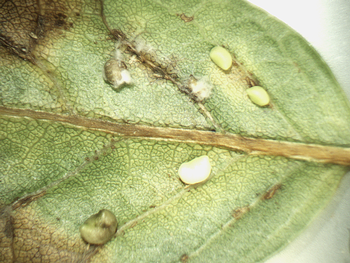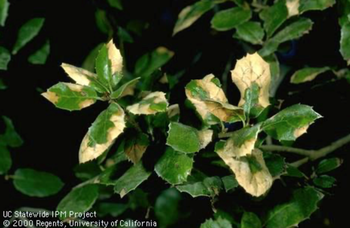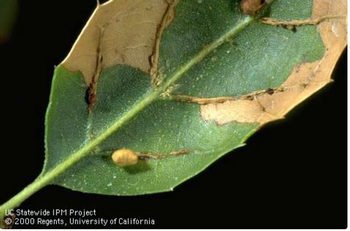Oak leaves turning brown? Could be the two-horned gall wasp...
-
Steven Swain, Horticulture Advisor, UCCE Marin
-
Many coast live oak (Quercus agrifolia) trees are showing unusual browning in their canopies in the last month or two. If you look carefully, you may see small, crescent-shaped galls forming on the undersides of the leaves, mostly along the lateral veins. The galls will initially be green, then turn brown, and then fall off the leaves entirely, leaving only dark brown scar tissue on the leaf veins where they had been attached.
 Check along the lateral veins to see if you can find galls forming. Photo: Bob Mauceli
Check along the lateral veins to see if you can find galls forming. Photo: Bob MauceliThe galls are the work of the two-horned gall wasp, Dryocosmus dubiosus, a tiny honey-brown wasp the size of a gnat. These tiny wasps are not dangerous to humans in any way, and they do not have horns; they’re named for the shape of the leaf galls they cause to form on the undersides of oak leaves. Female gall wasps use their stinger to deposit an egg in the leaf veins of a coast live oak leaf. The egg releases hormones into the leaf, causing it to form a small tumor (gall) around the egg. A tiny wasp larvae then hatches out of the egg, and eats the gall from the inside. When the gall is almost completely eaten, it turns brown and falls off the tree into the leaf-litter below. The tiny wasp pupates inside the gall, and then chews a hole in the gall casing, emerging as a member of the next generation of tiny gall wasps.
The two-horned gall wasp is just one of dozens of species of gall wasps that incubate their eggs in oak leaves. Many people are more familiar with the large, colonial galls (commonly called “oak apples”) found on valley oak branches and twigs. These follow a similar lifestyle as the two-horned gall wasp, but they’re colonial, with dozens of wasp larvae sharing a single gall, and they’re laid in branch tissue, not leaves. Other gall wasps make other types of galls on the leaves of other oak species, including jumping galls (that hop if they land on hot pavement), and some spectacularly colored galls that look like tiny red crowns, or yellow turbans. Coast live oak leaves with brown, scorched margins due to feeding on the leaf underside by two-horned oak gall wasp. Photo: Jack Kelly Clark
Coast live oak leaves with brown, scorched margins due to feeding on the leaf underside by two-horned oak gall wasp. Photo: Jack Kelly ClarkWhen the galls of the two-horned gall wasp form on a leaf vein, it cuts off the flow of nutrients to the outer portion of the leaf. The leaf edges then turn brown after a week or two, giving the leaf a mottled appearance. If there are a lot of galls on a single leaf, it may turn entirely brown. Fortunately, this isn’t as bad for the oak as it may appear. Even if most of the leaves on an oak tree are affected, the wasps don’t damage the leaves until the fall. By then, the oak has often recovered its investment in the leaves in terms of the amount of sugar it gets back from them. Thus, while the tree may not look as good as we’d like, the damage isn’t as bad as it may seem.
These wasps are native to California, and form galls on oak leaves every year. Like all things in nature, their populations are kept in check by other creatures in the ecosystem. One of the most important checks on gall wasp populations is another species of gall wasp (a parasitoid) that lays its eggs in the galls of other wasps. The parasitoid wasp eats the gall wasp larva. One possible explanation for this year’s large outbreak is that something happened in the last year or two to cause the parasitoid population to crash, which then enabled many more gall wasps to survive. However, with an abundance of food available, it’s likely that parasitoid populations will rebound this year, and the problem is not likely to recur in 2024. Galls, and necrosis where galls dropped from the leaf, caused by two-horned oak gall wasp infesting coast live oak. Photo: Jack Kelly Clark
Galls, and necrosis where galls dropped from the leaf, caused by two-horned oak gall wasp infesting coast live oak. Photo: Jack Kelly ClarkWe can all hope that’s the case, as treatment of gall wasp infestations is not well-researched. No effective control methods are currently known, or likely required. We expect afflicted oaks will do much better in 2024, even if we do nothing.



